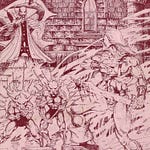The 1980s and 1990s in the US witnessed a profound and unsettling cultural phenomenon; a nationwide moral panic centred on allegations of widespread Satanic activity involving child exploitation, murder, and ritual abuse. This era, often termed the ‘Satanic Panic,’ saw law enforcement agencies, media outlets, and societal institutions converge around a narrative of hidden evil that, despite a near-total absence of credible evidence, reshaped criminal investigations and destroyed lives. It exposed systemic failures in the justice system, with investigations into these imagined networks of Satanists rooted in fear, ideology, and pseudoscience. This modern witch hunt reveals how moral crusades can amplify paranoia, distort truth, and perpetuate injustice.
The origins of this panic lay in a volatile intersection of cultural, political, and religious forces. The rise of evangelical Christianity in the late 1970s, with its emphasis on spiritual warfare against demonic forces, framed Satanism as both a theological and existential threat. Apocalyptic rhetoric permeated sermons and literature, such as Jack Chick’s graphic comic tracts depicting ritual murders. At the same time, psychiatrist Lawrence Pazder’s controversial book Michelle Remembers (1980) popularized the idea of repressed memories of satanic abuse. Moving towards the turn of the millennium too gave rise to apocalyptic cults believing in the end of the world as we know it. These narratives gained traction alongside broader societal shifts, including the feminist movement’s focus on violence against women and children, which, while vital in advancing protections, inadvertently created a framework for interpreting unverified claims as systemic truth. Media sensationalism further ignited public fear. Geraldo Rivera’s 1988 NBC special Devil Worship: Exposing Satan’s Underground claimed over a million Satanists were operating in the US, committing atrocities in secret. Talk shows like Donahue and Oprah amplified these stories, normalising conspiracy theories and eroding public scepticism. Simultaneously, new mandatory reporting laws for child abuse, enacted in the early 1980s, led to a surge in investigations, often guided by social workers and therapists who employed leading questioning techniques that coerced false confessions from children.
Law enforcement agencies, ill-equipped to navigate this hysteria, became unwitting participants in perpetuating myths. Training materials such as the Law Enforcement Guide to Satanic Cults (1994) instructed officers to interpret doodled pentagrams, innocuous symbols, heavy metal lyrics, or roleplaying games like D&D as evidence of criminal cult activity. Self-proclaimed ‘occult experts,’ many with ties to evangelical organizations, conducted seminars where they conflated teenage rebellion with organized Satanism, teaching police to profile individuals based on speculative criteria. Interrogations of children, particularly in daycare abuse cases, relied on discredited methods. In the McMartin Preschool trial (1983-90), the most protracted and most expensive criminal case in US history, prosecutors spent $15 million pursuing over 300 charges against seven staff members. Investigators and therapists asked children leading questions, rewarding them with praise for increasingly fantastical claims; involving animal sacrifice, secret tunnels, and teachers flying through windows. Naturally, physical evidence failed to materialize, no tunnels were ever found. Authorities dismissed contradictions as proof of the cults’ cunning. Similarly, in Bexar County, Texas, Melvin Quinney was convicted in 1991 after his children, subjected to months of coercive therapy, accused him of leading a cult that murdered infants. Decades later, his children recanted, explaining that therapists had implanted false memories through suggestive techniques. Quinney, exonerated in 2023 after 32 years on the sex offender registry, became a symbol of the panic’s enduring human toll.
The legal system’s failures were compounded by institutional complicity. Mental health professionals, particularly those treating dissociative identity disorder, often conflated therapy with criminal investigation. Therapists like Bennett Braun, who claimed patients harboured alter egos created by satanic abuse, used hypnosis and sodium amytal to extract ‘memories’ of non-existent crimes. These narratives were legitimized by federal funding; grants from agencies like the National Center on Child Abuse and Neglect prioritized research into ritual abuse, while conferences allowed prosecutors to share strategies for securing convictions, including suppressing exculpatory evidence. Religious groups, meanwhile, framed the panic as a divine battleground. Evangelical organizations hosted prayer vigils outside courthouses, while law enforcement trainers with missionary agendas blurred church-state boundaries, urging officers to spiritually cleanse crime scenes of demonic influence.
By the mid-1990s, the panic began to collapse under its own weight. Scholarly reviews, including a landmark 1994 study of 12,000 allegations, found no evidence of organized satanic networks. FBI behavioural analyst Kenneth Lanning, after a decade of research, concluded that claims of ritual abuse were absurd and rooted in urban legends. Courts grew sceptical of recovered memory testimony, with judges barring experts who promoted the theory. Insurance companies, facing costly lawsuits from daycare centres, hired investigators who exposed the lack of physical evidence and coercive interrogation tactics. Yet the legacy of this era endures. Families fractured by false accusations never fully reconciled; wrongfully convicted individuals faced lifelong stigma. Cult conspiracy theories resurfaced in modern movements like QAnon, which recycled tropes of secret elites abusing children, proving the tenacity of moral panic as a cultural force.
The Satanic Panic remains a stark lesson in the dangers of conflating ideology with justice. Law enforcement’s reliance on pseudoscience, the media’s appetite for sensationalism, and society’s readiness to believe in invisible threats underscore the vulnerability of institutions to fear-driven narratives. In today’s age of misinformation, these echoes of madness remind us that procedural integrity, rigorous evidence, and scepticism are not merely legal obligations but moral imperatives.













Share this post